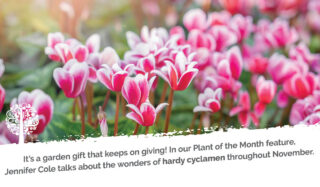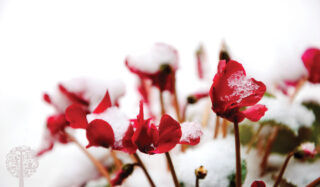I used to think of cyclamens as houseplants that my aunt grew on her windowsill, but I knew half the story! Several years ago, a neighbor gifted me a “hardy cyclamen.”
Although skeptical, I planted it outside, and it has since survived snowstorms, torrential rain, and frozen ground. It blooms around the beginning of November each year.
These small, hardy plants have variegated leaves and four-petalled tubular red, white, or pink flowers. Their leaves add interest when other stalwarts have disappeared, and their flowers brighten up gloomy November days. This low-maintenance perennial chugs along, happy to be ignored and to do its thing.

Hardiness, Light and Soil
Most outdoor cyclamens are hardy to at least climate zone 6 (-23°C). Small compared to other perennials, they are great in a rockery, alpine, or woodland garden where they can get a sun-part shade mix.
Some varieties can tolerate dry soil, but most prefer to be kept moist. In the fall, the moisture from rain and dew permeating the underlying soil layers jumpstart its growing cycle. Beginning in early September, continue watering cyclamens, even though it’s time to cut back on water in the rest of the garden.
Propagation
All cyclamens grow from single perennial tubers (swollen underground stems). The roots are noncompetitive, so planting cyclamen under a tree or beside large shrubs will not cause problems between plants.
Seed propagation is the best way to grow a new cyclamen. As the flower fades, seed pods full of sticky, sugary-coated seeds form. When the pod feels soft, open and scatter the seeds around the parent plant or start a new colony somewhere else in the garden.
Once rooted, cyclamens prefer to stay put, with some varieties living 100 years in the same spot. Yikes! Choose that garden spot carefully!

Pests
Most pests, including slugs and snails, aren’t interested in this low-maintenance plant.
Varieties
Garden centers are full of hardy cyclamen this time of year, with these four being readily available and popular choices:
Cyclamen pseudibericum has large leaves that unfurl to a dark, glossy green, marked with bands of gray. Large, rose-purple or pale pink flowers bloom in early winter to spring. This variety enjoys medium shade and is hardy to zone 7 (-17°C).

Hederifolium (aka Everyman’s Hardy Cyclamen) tolerates partial shade better than other varieties. It can begin to flower in late summer, but it dazzles in mid-late November with its rounded, silver-green leaves edged with darker greens. The underside of the leaf is maroon, and the flowers are pink, purple, or dark magenta. It’s a toughie and doesn’t care if it gets buried under snow – it survives.
Purpurascens (The Near Year-Rounder) will bud in late summer, just after last season’s foliage goes dormant.
Cyclamen repandum is great in containers and actually prefers being potted. Hardy to Zone 7, its delicate pink flowers have a slight scent. It’s a great choice to add to that late fall planter or early holiday display on the porch or patio.
What a great gift I received when I got my hardy cyclamen. I look forward to it every November! Join me In December for the plant of the month as we grow and garden together.